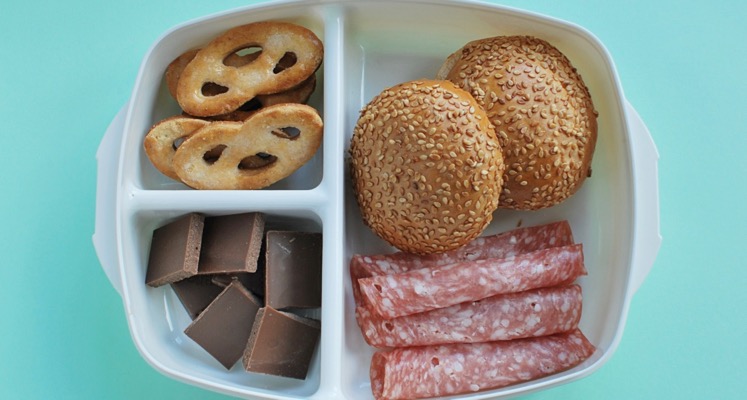Diets have improved slightly since 2004 but overall, Canadian children still need to improve the quality of their diets during school days. When zeroing in on recent data, researchers show the food categories needing most improvement were whole grains, milk and alternatives and dark green and orange vegetables.
When you’re walking down the halls of your child’s school, noticing cupcake wrappers in the garbage and cookie crumbs on the floor, do you ever ask yourself, “How well are children actually eating at school?” Well, researchers from UBC did.
Three UBC researchers recently analyzed the differences in children’s dietary intake patterns between school hours (9 a.m.–2 p.m.) and school days using national dietary data. Data obtained from the Canadian Community Health Survey (CCHS) from 2004 and 2015 were examined and compared. Information about what Canadian children ate and drank during school hours was obtained from over 7200 students. All food consumed by this group of children during school hours and the school day was categorized into 11 key components of a healthy diet (e.g. whole grains, milk and alternatives, whole fruit, etc.). The results? Researchers found small improvements in diet quality scores from 2004 to 2015 both during school hours (9 a.m.–2 p.m.) and during school days. Scores were matched or increased in all of the 11 components of a healthy diet from 2004 to 2015, except for the whole grains subcategory, where a decrease was found.
Although small improvements in dietary quality during school hours and school days were observed from 2004 to 2015, the overall nutritional quality scores still placed Canadian children’s diets in the ‘diet requires improvement’ category.
When zeroing in on 2015 data, children scored the lowest in the milk and alternatives, whole grains, and dark green and orange vegetables subcategories of food during school hours. Interestingly, public health campaigns have spent a great deal of focus on promoting fruits and vegetables as a way to eat healthier. However, promotion of whole grains and milk and alternatives is lacking in education campaigns.
Although small improvements in dietary quality during school hours and school days were observed from 2004 to 2015, the overall nutritional quality scores still placed Canadian children’s diets in the ‘diet requires improvement’ category. In fact, the overall diet quality scores of students were only 57 out of 100 for total school hour intake and 64.5 out of 100 for the total school day intake in 2015.
Does the source of food matter?
You may assume that if you are sending your child to school with a home-packed lunch, they are eating better. Good news; in most cases, you are right!
Researchers also looked into where students obtained food during school hours and if the food source impacted overall diet quality in Canadian children. Results found that almost 75% of students reported bringing lunch from home and the rest obtained lunch from off-campus locations, schools, or did not consume lunch at all. Home-packed lunches were found to be significantly higher in several nutrients and were associated with better diet quality compared to lunches obtained off-campus.
So home-packed lunches will solve all problems?
Well, no. Even though the nutritional quality of lunches obtained off-campus was lower than home-packed lunches, the diet quality of food was sub-optimal from all lunch sources. To make matters worse, new Canadian research identified that parents’ reporting of what they pack in their children’s lunch is quite different than what is actually packed. What does this mean? Students’ lunches are less healthy than originally thought. Results found that the average portion of sugary drinks packed in students’ lunches were significantly higher than what was reported by parents. Furthermore, parents reported that they packed a significantly higher amount of fruits, fruit juice, vegetables, milk/alternatives, and meat/alternatives compared to what was actually in the students’ lunches.
Even though the nutritional quality of lunches obtained off-campus was lower than home-packed lunches, the diet quality of food was suboptimal from all lunch sources.
Researchers have determined that strategies are needed to improve access to healthy foods at school and improvements should be made to the nutritional quality of home-packed lunches. Providing a quality lunch is important since lunch provides approximately ⅓ of the food consumed during the day by Canadian students.
Why does it matter what kids are eating at school anyway?
A healthy, balanced lifestyle is particularly important for kids because habits established in childhood set the foundation for healthy eating behaviours as adults. Furthermore, healthy eating for a child:
- Provides fuel for optimal growth and nutrients for strong bones, teeth, and muscles
- Aids in brain development
- Improves school performance, learning ability, attention span, and behaviour
- Supplies energy for daily activity
- Decreases the risk of becoming sick now and developing chronic diseases like type 2 diabetes, heart disease, and cancer later in life
What can YOU do to take action?
As a school
Implement the Guidelines for Food and Beverage Sales in B.C. Schools to help make the healthy choice the easy choice, and/or utilize Bake Better Bites, a recipe book full of healthy versions of baked goods for school fundraisers and classroom celebrations! The Brand Name Food List from HealthLinkBC is another helpful tool to aid in identifying healthy fundraiser foods from restaurants and pre-packaged items that meet the nutrition standards set for B.C. schools. Sign up for the BC School Fruit and Vegetable Nutritional Program and the +Milk program which provide students with fresh, local milk, fruits and vegetables twelve times a year. To make regular access to milk easier, look into the School Milk BC program.
As a teacher
Read more about BC Dairy Association’s free nutrition education workshops which prepare you to teach curriculum-based, grade-specific nutrition lessons to your students in a fun and engaging way that will help students develop lifelong healthy eating habits. In fact, an evaluation of the BC Dairy Association’s Food for Us program found that upon completion of this program, students were transformed into healthier eaters. Furthermore, it revealed that parents were packing healthier lunches for their children!
BC Dairy Association also offers mini food grants to teachers to help inspire their students to be healthier eaters! Read about how BC teachers have inspired students to make nutritious food choices.
As a parent
Invite your children into the kitchen to teach them how to prepare, bake, and cook foods using these 10 tips! You can also check out Better Together BC for loads of simple and delicious, kid-friendly recipes.

References
- Tugault-Lafleur CN, Black JL, Barr SI. Examining school-day dietary intake among Canadian children. Appl Physiol Nutr Metab. 2017;42:1064–72.
- Tugault-Lafleur CN, Black JL, Barr SI. Lunch-time food source is associated with school hour and school day dietary quality. J Hum Nutr Diet. 2018;31:96–107.
- Tugault-Lafleur CN, Black JL. Differences in the quantity and types of foods and beverages consumed by Canadians between 2004 and 2015. Nutrients. 2019;11(3):526.
- Hawthorn DL, Neilson LJ, Macaskill LA, et al. Parental reports of lunch-packing behaviours lack accuracy: reported barriers and facilitators to packing school lunches. (2018).Can J Diet Pract Res .2018; 12:1-7. doi: 10.3148/cjdpr-2018-011.
